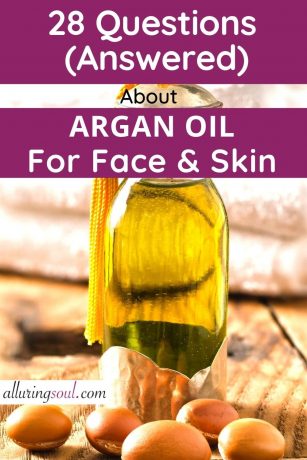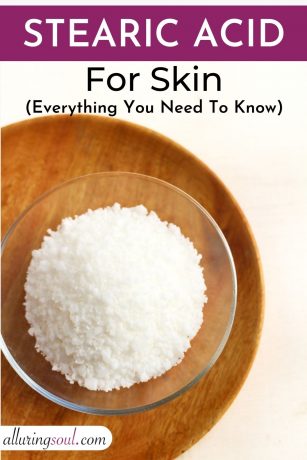Shea butter and cocoa butter are both well-known for having fantastic moisturizing and healing properties for the skin. But the main difference between shea butter and cocoa butter is that shea butter has a ‘0’ comedogenic rating which means it does not clog pores and cocoa butter has a comedogenic rating of ‘4’ which means it can clog pores and is not suitable for acne-prone skin.
Shea butter is obtained from the nuts of the shea tree and has a strong unpleasant odor in its unrefined form whereas cocoa butter is obtained from the cocoa beans and smells like chocolate.
Shea butter is soft and easy to break off and has a shelf life of 6-18 months whereas cocoa butter is rock solid and is difficult to break and has a shelf life of 3-5 years.
Cocoa Butter
Types Of Cocoa Butter
Cocoa butter is derived from the cacao beans found in the cocoa pod of the cacao plant. The pod consists of around 30-40 beans. The butter, also known as the fat, is extracted after drying, beating, and processing the beans. Based upon their extraction process, they are available in 2 different types-
1. Unrefined Cocoa Butter- This cocoa butter has a distinct smell similar to chocolate and possesses a pale yellow color. However, it has better healing properties as it retains all of its vitamins and other nutrients. It has a shorter shelf-life than refined cocoa butter.
2. Refined Cocoa Butter- This category of cocoa butter is stripped off from its characteristic scent and color and has also lost some of its nutrient value during the refining process. Hence, it is white in color. However, it has a longer shelf life compared to its other variant.
Which Is Better Cocoa Butter?
If planning to create a cosmetic product from scratch, unrefined cocoa butter is the best as it delivers the most healing and moisturizing benefits.
Benefits Of Cocoa Butter
- Antioxidant Properties- Cocoa butter is high in antioxidants such as polyphenols, which helps create a protective barrier on the skin to protect it from the damages caused by free radicals known to cause wrinkles and dark spots, and dull skin. This benefit aids in the skin to remain healthy and youthful-looking.
- Improve Skin Elasticity- One study has revealed that cocoa butter, with its high content of fatty acids, has the potential to improve skin elasticity and tone the skin. They seep deep into the skin to diminish the appearance of the signs of skin aging.
- Prevent Stretch Marks- There are many claims from women that cocoa butter has successfully reduced the appearance of stretch marks during and after their pregnancy with regular use. However, not much scientific evidence is available for this narrative. But, it is one of the most common uses of cocoa butter.
- Rich Moisturizer- The fatty acids contained in cocoa butter like oleic, palmitic, and stearic acids has the ability to nourish and hydrate the skin wonderfully. It holds on to the moisture and prevents it from escaping, thus preventing the skin from dryness.
Shea Butter
Types Of Shea Butter
Shea butter is a plant extract derived from the shea tree nuts native to Western Africa. Depending upon the methods of extraction of shea butter, it can be of 3 types –
1. Raw Shea Butter – It comes with some impurities and has a characteristic smoky smell that comes from roasting and comes in yellow or ivory color.
2. Unrefined Shea Butter – It is beige or ivory in color and can be filtered as long as the filtering methods don’t affect its quality. Also, it does not contain any chemicals.
3. Refined Shea Butter – It is white in color, contains no impurities, and has no distinctive smell. It has less healing and moisturizing properties due to the heavy filtration method.
Which Is Better Shea Butter?
For making skincare cosmetic products, it is recommended to use unrefined shea butter because it has fewer impurities and has 100% healing and moisturizing properties.
Benefits Of Shea Butter
- Suitable For Acne-prone Skin – Apart from delivering moisture and repairing dry skin, shea butter is also suitable for acne-prone skin. It has a ‘0’ comedogenic rating, meaning it will not clog pores and cause breakouts.
- High In Vitamin A, E, and F – With the richness of these vitamins, shea butter is known to deliver great cell regenerative and moisturizing properties. As a result, it stops the skin from forming early signs of aging such as wrinkles, age spots and makes the skin firm. Also, it repairs and heals damaged skin and makes skin healthy and glowing.
- Deep Conditions Dry Hairs – Moreover, shea butter helps to hydrate and nourish hair strands, reduces frizz, and prevents hair breakage and split ends due to its moisturizing properties. It stops scalp infections, dry and flaky skin.
- Treats Inflammatory Skin Conditions- Shea butter has anti-inflammatory and anti-bacterial properties, which give it the potential to heal and help calm red, irritated, and itchy skin. It also moisturizes and nourishes dry and flaky skin and helps to treat skin conditions like eczema, psoriasis, and dermatitis due to its antibacterial properties.
- Rich Fatty Acids – Shea butter has great emollient properties thanks to its rich concentration of stearic and oleic acids. And, these essential fatty acids help to hydrate and soften the skin while also strengthening the skin barrier. They get easily absorbed into the skin and help to prevent stretch marks by increasing the skin’s elasticity.
Shea Butter Vs Cocoa Butter – Which Is better?
Both of the plant-extract shea butter and cocoa butter have the same moisturizing and skin-repairing benefits. However, if you are prone to acne, the best option is to go for shea butter, as cocoa butter can clog pores as it has a comedogenic rating of 4. Also, shea butter is rich in Vitamin A, E, and F.
Unrefined shea butter has been found to be an excellent natural cure for treating eczema, while unrefined cocoa butter holds the top position as a solution to stretch marks.
Shea butter also has high healing properties as it is a good source of Vitamin A and E, so it helps to reduce any inflammation on skin and repair damaged skin. On the other hand, cocoa butter contains CMP (cocoa mass polyphenols), which prevents rashes and dermatitis and acts as a protective layer when applied to the skin.
You can use the combination of shea butter and cocoa butter for your creams and lotion to enhance the moisturizing properties, and you will get the benefits from both of them.
Table Showing The Comparison Between Shea Butter And Cocoa Butter
| SHEA BUTTER | COCOA BUTTER | |
| Sources | Nuts of the shea tree | Cocoa beans |
| Smell | Nutty and unpleasant | Aroma of cocoa |
| Appearance | Soft and easy to break off | Hard to break |
| Shelf Life | 6-18 months | 2-5 years |
| Skin Types | Best for all skin types | Best for all except acne-prone skin |
| Benefits | Treats eczema, damaged skin, and other inflammatory skin issues | Treats stretch marks, rashes, and dermatitis |
| Vitamins | Vitamin A and C | CMP (cocoa mass polyphenols) |
Can you mix shea butter and cocoa butter?
Yes, mixing shea butter with cocoa butter is safe. In fact, this combination will deliver exceptionally good moisturizing properties. Whip these two together to achieve a smoother texture without them turning oily.
Shea Butter vs Cocoa Butter For Stretch Marks
Both of them are effective in diminishing the appearance of stretch marks. The leading cause of Stretch marks is when the skin gets stretched beyond its capable elasticity. In the process, they damage the collagen fibers of that area, and the skin witnesses discoloration. But, shea butter, with its high ratio of fatty acids, including oleic, palmitic, and linolenic, aids in fixing that damaged area by boosting collagen production. The butter also constitutes Vitamin A that helps to increase the elasticity of the skin.
And cocoa butter helps by seeping deep into the dermis (middle layer of the skin), where the stretch marks form. Its property to hydrate and nourish skin so deeply helps to improve skin’s elasticity with regular use since moisture plays a significant role in maintaining the elasticity of the skin. Moreover, it boosts collagen production as well.







No Comments